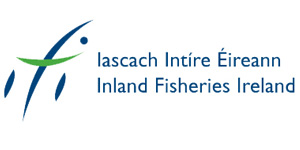How are fish surveyed?
Fish stock assessment is one of the key activities required by the Water Framework Directive. Inland Fisheries Ireland is developing new ecological classification systems for rivers, lakes and transitional waters (estuaries) using fish as indicators of water quality.
What fish survey methods are used for monitoring fish for the WFD?
Electric fishing and many forms of netting (gill netting, fyke netting, seine netting and beam trawl) are the principal survey methods being used to monitor fish for the Water Framework Directive. Hydroacoustics (echosounding) is also being developed for surveying fish in lakes and deep rivers
Rivers – Electric-fishing
Electric fishing is the method of choice for surveillance monitoring of fish in rivers to obtain a representative sample of the fish assemblage at each sampling site. The technique complies with CEN guidance for fish stock assessment in rivers.
Where possible each site is isolated using stop nets and three fishings are carried out using hand set (single or multiple units) or boat (single or multiple units) electric fishing equipment. Fish from each pass/fishing are sorted and processed separately.
All fish present are identified, measured for length and weight and scales for age analysis are removed. All fish are held in a large bin of oxygenated water after processing until they are fully recovered and are then returned to the water. Some fish are retained for further analysis.
A number of physical habitat variables are measured at each site to complement the fish species lists. A multihabitat kick sample and a plant survey are also carried out at some sites.


Lakes – Multi-method approach
The standard method for sampling fish in lakes is a multi-method approach which includes the use of monofilament multimesh benthic and surface survey gill nets, large mesh braided gill nets and Dutch type” fyke nets.
The netting procedure is carried out in accordance with European standard protocols (CEN, 2005) which were tested during the NS Share “Fish in Lakes” project (Kelly et al., 2009). The location of each net is randomly selected. Handheld GPS instruments are used to mark the precise location of each net deployed. The angle of each gill net in relation to the shoreline is randomized. All fyke net units are set perpendicular to the shore. All nets are set between 3 and 6pm, fished overnight and lifted between 10.00am and 12.00 midday in order to ensure that the activity peaks of each fish species are included. Where possible, fish are returned to the water alive.
All fish captured are identified, measured (fork length) and weighed. A sub sample of fish from each lake is also examined for sex, stomach contents. Scales/opercular bones/otoliths are removed for age and growth determination.
A water sample is collected from the middle of each lake and transported to the CFB laboratory for analysis. Conductivity, temperature, dissolved oxygen and pH are measured on site using a YSI multiprobe. A Secchi disc is used to measure the clarity of the water in each lake.
References
CEN (2005) Water Quality Sampling of Fish with Multi-Mesh Gillnets. European Committee for Standardization, EN 14757.
Champ, W.S.T, Kelly, F.L. and King, J.J. (2009) The Water Framework Directive: using fish as a management tool. Biology and Environment: Proceedings of the Royal Irish Academy, 109B, 191-206


Estuaries – Multi-method approach
The standard method for sampling fish in estuaries is a multi-method approach which includes the use of seine nets (30m fine mesh net to capture fish in littoral areas), beam trawls (trawling for specified distances – 100 to 200m – in open water areas adjacent to beach seining locations and fyke nets (these are set overnight in selected areas adjacent to the beach seining locations).
The method aims to sample fish in a representative range of littoral and open water sites, characteristic of the estuary under study.

New technology – Hydroacoustics
Hydroacoustics is the use of high frequency sound to measure the densities, spatial distributions and sizes of fish. Scientific echosounders transmit short bursts of directed, high-frequency sound into the water using a beam-forming transducer (device that converts electrical energy into sound energy and sound energy into electrical energy). Sound propagates in the water as a pressure wave; any object whose density differs from that of the water (e.g. fish) scatters a fraction of the pressure wave back to the transducer (scattered sound = echo). With the aid of acoustic data processing software, the returning echoes are used to calculatefish densities, map fish spatial distributions and measure the size of individual fish targets.
Many species of fish are known to school and shoal. Such behaviour cause fish to be non-uniformly distributed within the aquatic environment. Non-uniform or patchy fish spatial distributions create many logistical and statistical problems for net or trap surveys of fish abundance. Hydroacoustics has several advantages over the more traditional fish sampling methods:
- Rapid and continuous sampling of the water column over large areas
- Cost-effective
- Low fish avoidance
- Non-invasive
- Quantify fish distributions over large areas

